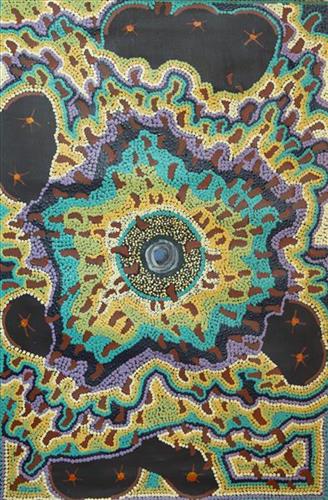111582384765
Ngurra kujungka
“It’s a painting about family, it’s the Martu way. Families been travelling, they come together, ngurra kujunka (coming together in one home place). They got their wuungku (windbreak) there, waru (fire), and it’s for hunting, gathering bush tucker. The footprints – they have to stamp it [the knowledge] and leave their stories to the young ones, pass it generation to generation. Ngurra kujungka is Martu determination, from Manyjiljarra, right up to Pintupi, Ngaatjatjarra, Warnman. This is the showing all the jurnu (soaks) and rockholes, every kapi (waterhole) – that’s the centre of ngurra (home/country/camp). Land need Martu to be strong, and Martu need the spirit of the land, it’s a strong one”
– Christopher James
The Western Desert term ‘ngurra’ is hugely versatile in application. Broadly denoting birthplace and belonging, ngurra can refer to a body of water, a camp site, a large area of Country, or even a modern house. People identify with their ngurra in terms of specific rights and responsibilities, and the possession of intimate knowledge of the physical and cultural properties of one’s Country. This knowledge is traditionally passed intergenerationally through family connections. Country for Martu is full of memory; not just the memory of their own movement through it, but also of their family. As summarised by Ngalangka Nola Taylor, “painting the ngurra, they do it to remember their connections.”
Painting ngurra, and in so doing sharing the Jukurrpa (Dreaming) stories and physical characteristics of that place, has today become an important means of cultural maintenance. Physical maintenance of one’s ngurra, like cultural maintenance, ensures a site’s wellbeing, and is a responsibility of the people belonging to that area.



